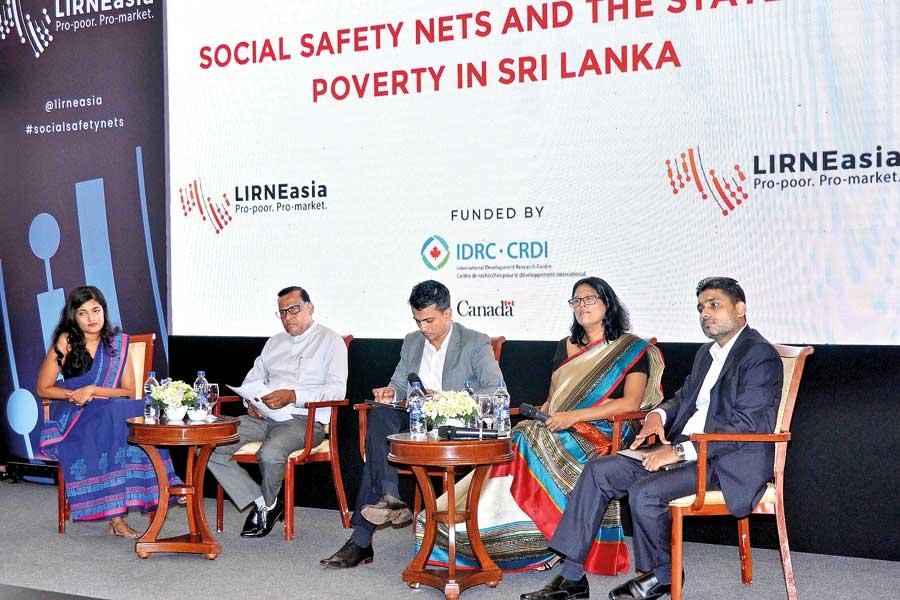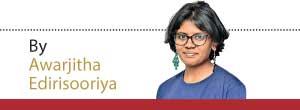Reply To:
Name - Reply Comment

Advocata Research Institute CEO Dhananath Fernando (centre) is seen speaking to the audience as the moderator of the event titled ‘Social Safety Nets and the State of Poverty in Sri Lanka’ and held in Colombo (Pix by Nisal Baduge)
A survey has revealed that the existing social assistance programme Samurdhi has failed to reach out to the poorest in the society. In addition to that only 31% of the poorest in every 10 households receive Samurdhi while 4% of the richest households also enjoy the same benefit.
in every 10 households receive Samurdhi while 4% of the richest households also enjoy the same benefit.
The urban population living below the poverty line by 2023 is 10% while the rural population living below the poverty line is 81%. The estate population living below the poverty line is 10%.
Many speakers expressed their views at an event titled Social Safety Nets and the State of Poverty in Sri Lanka and held in Colombo.
Only 31% of the poorest in every 10 households receive Samurdhi while 4% of the richest households also enjoy the same benefit
LIRNEasia Research Manager Gayani Hurulle said “It is of concern that an additional 4 million Sri Lankans have fallen into poverty in such a short period. Families have had to prioritise one child’s education over other members of the family. Many parents that we met indicated that they cannot afford to offer their children a balanced diet. The country must protect the vulnerable during these challenging times by spending adequately on social safety nets. Not only do sufficient funds need to be allocated to social safety nets, the funds allocated should be utilised efficiently,” said Hurulle.
In addition to that this is a national survey conducted by studying 100,000 Sri lankan households. The survey was conducted across 400 Grama Niladhari divisions. It is reported to be a qualitative research done in the form of key informant interviews, focus group discussions, in depth interviews and structured observations were undertaken with over 400 individuals across 13 districts.
Due to the poverty level most of the people have even had to skip their meals too. According to the LIRNEasia survey as much as in 27% of the households adults have skipped their meals with the intention of feeding their children.
It is of concern that an additional 4 million Sri Lankans have fallen into poverty in such a short period. Families have had to prioritise one child’s education over other members of the family. Many parents that we met indicated that they cannot afford to offer their children a balanced diet
- Gayani Hurulle LIRNEasia Research Manager
Dharshani (name changed to protect privacy), a 37-year-old mother from Nuwara Eliya, whose husband is a casual labourer, shared her experiences with the LIRNEasia team. “It was nice and sunny two days ago, but my husband couldn’t find much work. He travelled all over [the town looking for work] but returned home in the evening with very little money. We bought some food with that money and cooked it for the children. I went hungry. I have gone hungry for several days like that. But I don’t show my family that I don’t eat,” said Dharshani.
Moreover it seems like this poverty had led to the trading system, since this survey represents that 37% of households had sold their household assets to purchase food, while 50% had utilised their savings for this purpose.
Ranjini (name changed to protect privacy) a 36-year-old mother from Kandy had explained to the researchers that she has pawned her jewellery when she didn’t have enough funds to feed her family.
The country must protect the vulnerable during these challenging times by spending adequately on social safety nets
LIRNEasia Project Manager and Statistician Tharaka Amarasinghe commented ,“The economic crisis has been so severe that 7 million Sri Lankans are living in poverty. Our research highlights the lengths people have had to go to get a meal on the table. We met individuals who have given up consuming proteins altogether and vegetables on most days. They’re surviving on a diet of rice and dhal. We need to continue reforming our social safety nets, so that it reaches the most vulnerable in society.” said Amarasinghe
According to the research done by LIRNEasia Samurdhi banks were regulated and brought into the formal banking system hence bank account ownership would rise to 71% and fewer people would need to open a new bank account to receive benefits.
“One person checks if a loan has been obtained. Another person checks if the loan has been repaid. Another person checks if there are arrears in repayment. So, there are many ledgers,” said Thilanka (name changed to protect privacy) as she shared her experiences with the LIRNEasia research team.
As much as in 27% of the households adults have skipped their meals with the intention of feeding their children
“Some beneficiaries may find that existing banks are closer to their homes; some may find that Samurdhi banks are closer to their homes. Giving them the option to collect their benefits from either should reduce the time spent on travelling to the collection point and reduce congestion at each point. If they are eventually able to withdraw money from ATMs, collection times would also improve further. However, we must address the underlying issues in the Samurdhi Bank system before presenting it as a viable alternative to the existing banks. Human resources should be made more efficient, and backend processes digitalised to improve the beneficiary’s experiences,” added Hurulle.